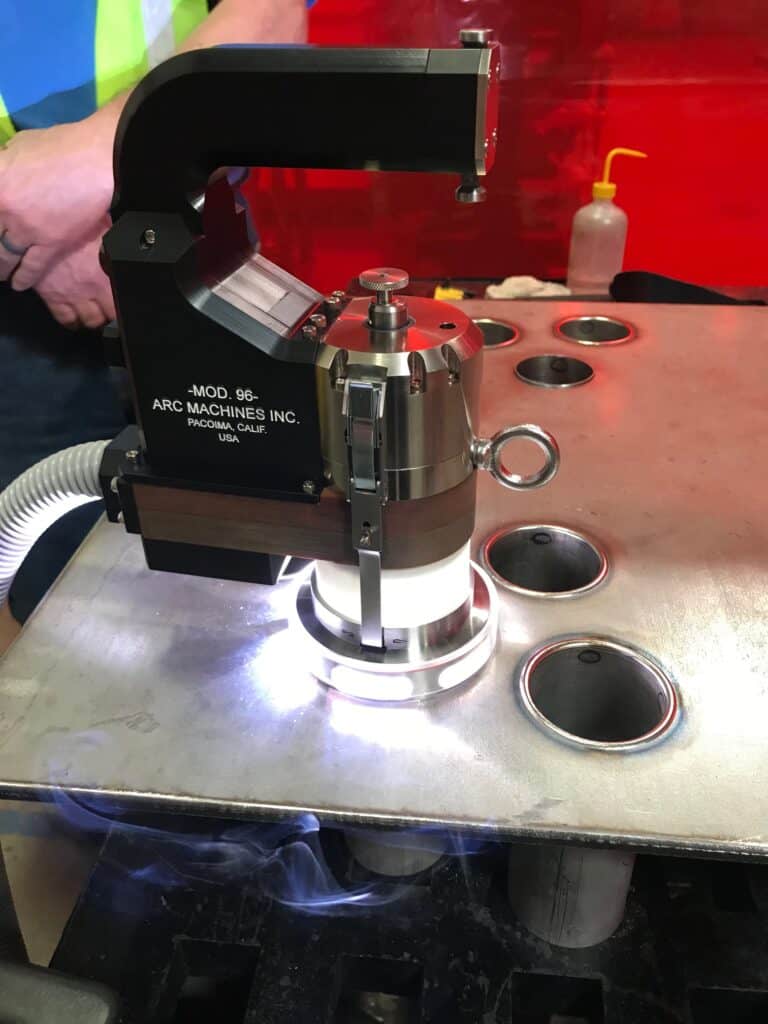
In heat exchangers or industrial condensers, tubes are contained within a large shell where they increase or lower the process fluid temperature. These tubes are held in place with the help of tube plates primarily made from low-carbon steel.In environments where corrosion is a significant threat—such as in marine or chemical applications—nickel alloys like stainless steel and cupronickel may be used.
Fabricating tube plates and attaching the tubes to tube sheets is precision work. Cupronickel may be easy to weld, but it requires a higher degree of accuracy and cleanliness. Let’s take a closer look at this nickel-copper alloy, explore the advantages of using a cupronickel tube plate, and examine the techniques used when welding them.
Tube Plates and the Need for Cupronickel
Tube plates are sheets of metal carefully designed with holes to hold the tubes in place. The tube-to-tubesheet connection often is accomplished by welding to ensure the required stability and prevent potential leaks. With this connection, the tube plates facilitate heat transfer from the process fluid to accelerate heating or cooling in applications ranging from nuclear power plants to desalinization plants. Tube plates are displayed prominently in shell-tube heat exchangers, boilers, and condensers in large-scale applications, and they usually are made of corrosion-resistant metal such as cupronickel.
Cupronickel is an alloy that can address the challenging demands that tube plates face, including:
- Extreme temperature and pressure conditions
- Tube to tube plate connection failure due to degradation caused by steam
- Erosion/corrosion due to chemical exposure
- Excessive stress at the connection point
It is easy to fabricate high-quality components with cupronickel if the cleanliness specification is met. At a variety of temperature ranges, cupronickel can maintain its properties. This characteristic can prove advantageous in critical nuclear or thermal applications where issues, such as thermal fatigue or creep damage from elevated temperatures, can be prevented. Cupronickel is also lauded for its resistance to corrosion, making it ideal for fabricating tube and tube plates for chemical processing or offshore components. Cupronickel tube sheets are relatively thick and can provide the required strength and toughness to support the tubes.
Although advantageous, cupronickel tube plates are costly, and any discrepancy in welding and fabrication can be expensive and cause significant setbacks for the manufacturer. Combining the right welding technique and equipment is key to high-quality cupronickel tube plate welding.
Welding Cupronickel Tube Plates
Cleanliness is the primary requirement cupronickel demands when welding tube plates and tubes. Additionally, the compact arrangement of the tube-to-tubesheet connection can increase welding complexity. To simplify the process, assess the application to determine the proper joint type. Then, use an automated welding process and quality weld equipment to create a tube-to-tubesheet joint.
- Operators may create expand and seal or strength joints depending on their leak resistance and mechanical strength requirements.
- Selecting the appropriate technique is the key to fabricating a high-quality tube and tube plate weld. With fusion GTAW, especially autogenous GTAW, strict tube plate welding standards can be met cost-effectively.
- Tube-to-tubesheet weld heads can help reduce the operator’s exposure to hazards that are common when multiple welds must be performed in closed or compact spaces. Additionally, 360-degree accessibility to each tube plate, which may be difficult to achieve manually, is available.
Using Tube-to-Tubesheet Orbital Weld Heads
For large or small welding projects, orbital welding techniques promote:
- Safety– Operators remain a safe distance away from the tight workspace.
- Precision– Auto weld heads can carry out the welding to the set parameter.
- Accessibility– Each tube and tube plate joint is easily accessible by the weld head, which is especially useful when repairs are required.
- Quality– Constant remote monitoring helps ensure precise, high-quality welds.
Tube to tubesheet orbital weld head solutions, such as AMI’s Model 6 and Model 96, can perform multiple passes of tube and tube plate welding in any position with a high degree of precision. Solutions like these make working with cupronickel tube plates cost-efficient and productive.
Arc Machines, Inc. has decades of expertise in providing high-quality automated orbital welding equipment and service to help you meet your tube-to-tubesheet welding needs. For consistent and high-quality results when welding cupronickel tube plates, consider our orbital tube to tubesheet weld heads. For further inquiries regarding these products, contact sales@arcmachines.com. For service inquiries, contact service@arcmachines.com. Arc Machines welcomes the opportunity to discuss your specific needs. Contact us to arrange a meeting.





